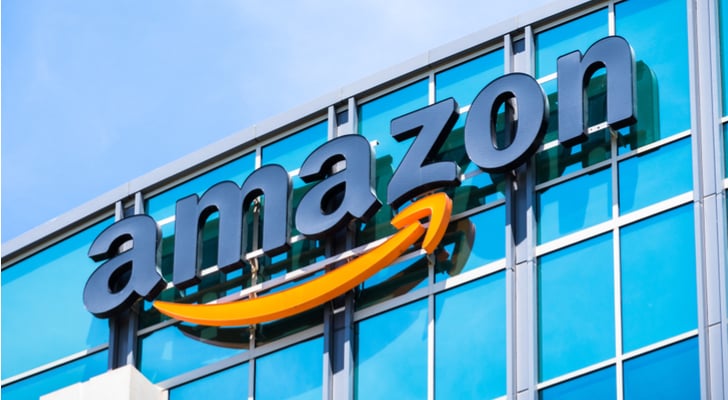In 2018, Amazon (NASDAQ:AMZN) announced that it intended to open 3,000 new cashier-less Amazon Go convenience stores by 2021. That was a big announcement for Amazon stock.
Less than ten Amazon Go stores were operating at the time. Convenience-store-giant 7-Eleven has less than 10,000 locations in the U.S. Thus, Amazon was stating that it wanted to go from being nobody to being somebody in the offline-convenience-store world.
Since that announcement, the market has largely forgotten about the expansion of Amazon Go. Amazon stock has subsequently dropped into bear-market territory amid broader economic and market uncertainty. Investors are calling into question the valuation of Amazon stock as interest rates rise. Investors are also concerned about Amazon’s margins and the elevated competition it’s facing in the e-commerce world.
But long-term investors should not dismiss the growth potential of Amazon Go.
It will take a while for Amazon Go to move Amazon stock. But Amazon Go has the potential to become a $20 billion business, and that’s big enough to make some noise. So the expansion of Amazon Go is yet another reason for long-term investors to buy and hold Amazon stock.
Where Amazon Go Will Be by 2021
By 2021, Amazon Go has the potential to be a multi-billion-dollar business.
RBC Capital recently released a note saying that the average check at Amazon Go stores is roughly $10. RBC estimates that Amazon Go stores generate about $1.5 million of revenue per year. That is 50% more than the average convenience store.
Assuming the stores’ average annual revenue stays around $1.5 million for the foreseeable future, and Amazon does open 3,000 stores by 2021, then that equates to $4.5 billion in annual sales. It will be a low-margin business, much like Amazon’s e-commerce business. By 2021, 2%-3% operating margins can be generated. A 2%-3% margin on $4.5 billion equates to about $110 million of operating profits.
After paying taxes of 20%, Amazon Go will be left with $90 million in net profits by 2021. Utilizing a price-earnings multiple of 20, we arrive at a valuation of $1.8 billion. Amazon stock has a $700 billion-plus market cap. In other words, Amazon Go will be just a drop in the ocean by 2021.
But that’s just the tip of the iceberg.
Where Amazon Go Will Be in Ten Years
Amazon doesn’t like to get into industries unless it can dominate the space. For example, the company created the most robust e-commerce ecosystem in the world, and AMZN became the runaway leader of the global-cloud-services market.
AMZN will have similar success in the convenience-store sector. Given the company’s track record of being relentless until it dominates industries, 3,000 stores by 2021 is just the beginning.
7-Eleven has more than 60,000 stores around the world. It will be tough for Amazon to get to that level, since opening an Amazon Go cashier-less store is far more expensive than opening a relatively primitive 7-Eleven store. Also, Amazon likes to open offline stores in a limited number of locations. For instance, Amazon acquired Whole Foods, which has about 500 stores. That is roughly one-sixth the number of stores that leading grocer Kroger (NYSE:KR) operates.
7-Eleven operates ~60,000 stores. One-sixth of that is 10,000 stores. Average unit volumes should explode higher by then, given increasing consumer awareness and Amazon’s intention to make Amazon Go more of an eatery than a convenience store. Top eateries generate more than $2.5 million of sales per store. Average unit volumes around $2.5 million on a 10,000-store base equates to potential revenue of $25 billion.
Amazon Go’s operating margins should rise as more stores are opened, getting close to Walmart’s (NYSE:WMT) level of 5%. A 5% operating margin on $25 billion in sales leaves us with $1.25 billion of operating profits. After taking out 20% for taxes, Amazon Go can generate $1 billion of net profit.
Using a price-earnings multiple of 20, we get a valuation of $20 billion for Amazon Go. That’s twice the size of Macy’s (NYSE:M). market cap Suddenly, these numbers start to become meaningful for Amazon stock.
The Bottom Line on AMZN Stock
When it comes to Amazon stock, there are simply too many growth drivers to ignore. The expansion of Amazon Go is just one of those many growth drivers, and it’s a $20 billion-plus opportunity for the company.
In the long run, as these growth drivers emerge over the next several years, AMZN will continue to grow its revenues and profits at a brisk pace. Companies that are able to do that tend to have rising stocks, too. As a result, Amazon stock should be bought and held for the long run.
As of this writing, Luke Lango was long AMZN, KR, and M.

